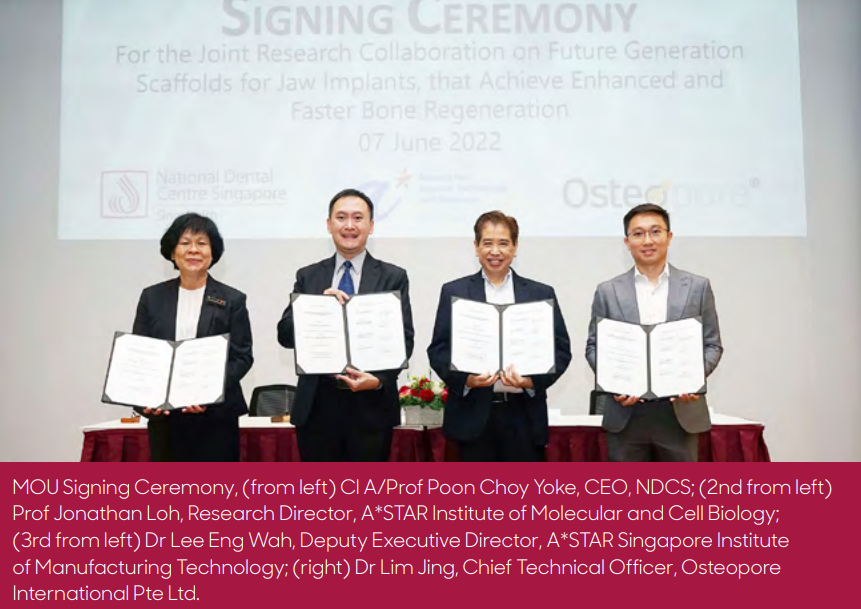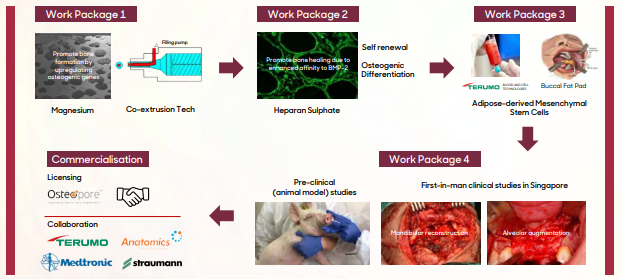The growing prevalence
of bone damage caused
by ageing, diseases, and
accidents makes bone the
second-most transplanted
tissue in the world, with the
bone graft and substitute
market valued at $3 billion
in 2019 and a projected
Compound Annual Growth
Rate (CAGR) of 5.5% by 2027.
The importance of bone grafts
extends to the field of dentistry.
Healthy oral-maxillofacial bone
tissue is critical for maintaining
oral function and quality of life,
and bone grafts are widely
used by dental surgeons
to restore bone in the oral�maxillofacial region, including
alveolar ridge augmentation
for dental implant installation,
mandibular reconstruction
after disease or trauma, and
cleft reconstruction. The
market for dental bone grafts
and substitutes is significant,
with a value of $551 million in
2020 and a projected CAGR
of 9.8% to reach $883 million
by 2025.

The multidisciplinary NISO
project (National Dental
Centre Singapore, Institute of
Molecular and Cell Biology,
Singapore Institute of
Manufacturing Technology,
Osteopore International) is
helmed by National Dental
Centre Singapore (NDCS).
The project aims to create
jaw implants that promote
faster bone growth and simplify future dental
procedures, while also
reducing the need for complex
bone harvesting processes,
risk of adverse immune
reactions and disease
transmission. This innovative
technology of a novel
Polycaprolactone (PCL)-
based synthetic scaffold
to successfully regenerate
bone, has the potential to
revolutionise the field of
bone grafting and make the
procedure safer and more
accessible for patients.
PCL is a bioresorbable,
non-toxic, biocompatible
polymer that has been
approved by the US Food and
Drug Administration (FDA) for
use as a bone filler in medical
devices and has been shown to be effective in promoting
bone growth. The PCL-TCP-Mg
scaffold developed by the
NISO project is loaded with
Adipose-Derived Mesenchymal
Stem Cells (AD-MSCs) and
Heparan Sulphate (HS) for use
in non-walled oral-maxillofacial
defects such as alveolar or
mandibular defects. The
ultimate goal is to successfully
regenerate bone using
this scaffold. The patented
biological additives and
polymer compounds will be
combined and tested for
any adverse reactions, any
osteogenic differentiation
(indicating bone growth),
and higher osteogenic
differentiation (indicating
faster bone growth) through
pre-clinical studies and a first
trial in human subjects.

Partnership, Roles, and Product Rollout
The NISO collaboration, valued at $18.3 million,
is slated for three years and comprises a
core partnership with research and industrial
organisations, with each bringing a unique skillset
and expertise to the project.
National Dental Centre Singapore (NDCS)
will be responsible for formulating clinical problem
statements and coordinating in-vitro studies, pre�clinical studies, and clinical trials in collaboration
with other institutions and companies.
Institute of Molecular and Cell Biology (IMCB) will
be developing biological stimulants that can
accelerate bone healing.
Singapore Institute of Manufacturing Technology (SIMTech) will focus
on developing high-value manufacturing
technology for the production of regenerative
scaffolds that can provide a structure for
the growth of new bone tissue.
Osteopore
International, the leading company in the
application of tissue engineering technology,
will be expanding its product lines to include the
new generation of dental implants developed
as part of the project. The company also brings
a wealth of experience and expertise to the
project, making it well-positioned to succeed in its
ambitious goals.
The project partners are committed to
co-developing the know-how portfolio and
commercialising the novel PCL-TCP-Mg-HS3-
ADMSC scaffold products over the next 3-6
years through four workstreams.

The Impact NISO Project Brings to Dentistry
The Clinical-Industrial Partnership highlights the
value of collaborations in driving innovation and
improving healthcare outcomes, by leveraging
and synergising the strengths of both sectors.
This innovative technology has the potential
to revolutionise the field of bone grafting by
overcoming the limitations of traditional bone grafts and is expected to be widely adopted by
dental practitioners and patients due to its unique,
less intrusive nature. Overall, the use of PCL in
bone grafting represents an exciting development
in healthcare technology. It heralds a promising
step forward in the field of dental research
with significant advancements in effectively
addressing the needs of patients with better
surgical outcomes and shorter recovery times.

